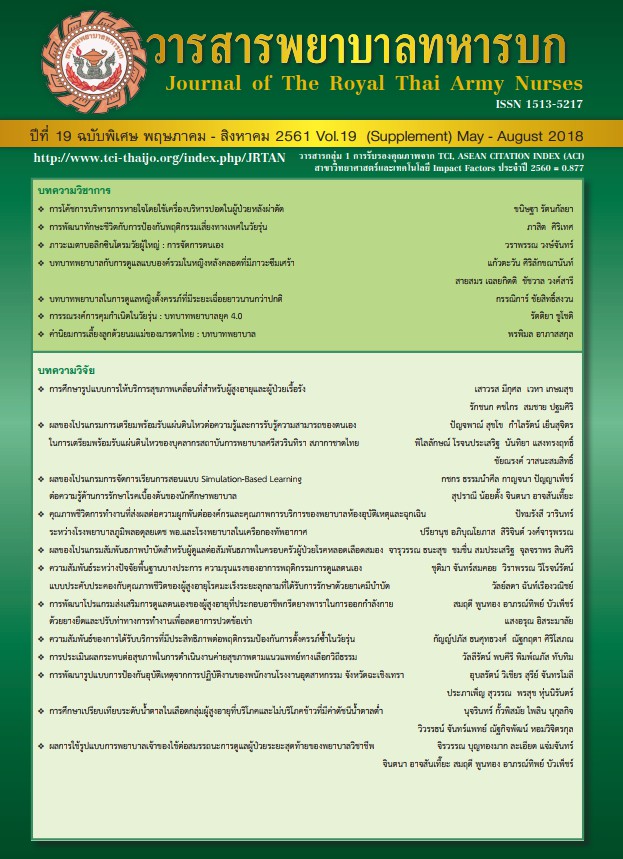Prolonged Latent Phase of Labor : The Midwifery Roles
Keywords:
Prolong latent phase, Midwifery rolesAbstract
Prolonged latent phase is a disorder of latent phase, which happens during the first stage of labor. It affects the physical and mental condition of the pregnant women and fetus. This article was written to guide midwifery in the care of pregnant women with prolonged latent phase. There are two guidelines of nursing care for pregnant woman, before and after admittance in the hospital . During the hospital stay, there are two pattern of care. The first is supportive care : Keep well hydrate and eat well, trying difference position, no bladder full, pain management, prevention of infection, environment care, good relationships . The second is specific care : determine the latent phase to distinguish the symptoms of false and true labor pain, therapeutic rest, avoid iatrogenic causes, audit and monitoring progress of labor, amniotomy and oxytocin infusion care. These methods can be used to provide appropriate nursing care.
Downloads
References
p. 374-409.
Friedman EA, Sachtleben MR. Dysfunctional labor VI. Abnormal progression in multipara. Obstet Gynecol 1963 Oct;22:478-94.
Chlemlow D, Kilpatrick S, laros R. Maternal and Neonatal outcomes after Prolonged Latent phase American Journal of Obstretrics and Gynecology 1993;81(4) : 488-491
Gross M, Haunschild T, Stoexen T, et al. Woman’s Recognition of the spontaneous Onset of Labor Birth. 2003; 30:267-271
Bodil Wilde-Larsson RNT, PhD, Ingegerd Hildingsson RNMT, PhD, Ann-Kristin Sandin-Bojo RNMT, PhD. Prevalence of Prolonged Latent Phase and Labor Outcomes:Review of Birth Record in Swedish Population.Journal of midwifery & woman’s Health. | Published online: 08 Feb 2018 – Volume 63- Issue 1. [Internet]. Available from : https://doi.org/10.1111/jmwh.12704.
Friedman EA. Labor : Clinical evaluation and management, 2nd ed.New york, Appleton-Century-Crofts,1978.
Tuntinirandorn. Y., Abnormal labor, in Rattanasiri. T., Suntornsuja. Thitima., Suthatwarawut. S. [Ed].Emergency Obstetricts. 1st ed. Bankok. Pimdee; 2009.Page 131-144 (in Thai)
Wong CA, Scavone BM, Peaceman AM,et al. The risk of cesarean delivery with neuraxial analgesia given early versus late in labour. N Engl J Med 2005;352:655.
Peisner DB, Rosen MG. Latent phase of labor in normal patients: a reassessment. Obstet Gynecol 1985; 66:664
Eri TS,Blystad A,Gjengedal E et al. Negotiating credilility:first-time mothers’ experiences of contact with the labour ward before hospitalization. Midwifery. 2010; 26:e25-e30.
Cheyne H, Terry R, Niven C, et al. ‘Should Icome in now?’: a study of woman’s early labor experiences. British Journal of Midwifery. 2007; 15(10):604-609.
J. Maghoma & E. J. Buchmann. Maternal and fetal risks associated with prolonged latent phase of labour. Journal of Obstetrics and Gynaecology . Pages 16-19 | Published online: 02 Jul 2009 - Issue 1. [Internet]. Available from : https://doi.org/10.1080/01443610120101637
Koontz WL,Bishop EH. Management of the latent phase of labor.Clin Obstet Gynecol 1982 ; 25 : 111- 4
Mackeen AD, Fehnel E, Berghella V, Klein T. Morphine sleep in pregnancy. Am J Perinatal. 2014 Jan ; 31(1):85-90. Epub 2013 Mar 7.
Sadler LC, Davison T, McCowan LM: Maternal satisfaction with active management of labor: a randomize controlled trial.Birth .2001; 28 : 225-235
Ziolkowski K :Induction of labor in prolonged pregnancy with propranolol as a personal evaluation. Article in Polish with English abstract. Pol Tyg Lek.1994; 49 : 184-185
Kelly, AJ, Kavanagh, J, Thomas J. Vaginal prostaglandin (PGE2 and PGE2a) for Induction of labor at term(Cochrane Review). In: The Cochrane Libraly, Issue 2, 2001.Oxford:Update Software.
Kongnguen, P. Sudjai, D. Abnormal First stage of Labor. Phupong V. [Ed]. Management of common problems in obstetricts.1st ed. Samutsakorn. Pimdee ; 2011: 205-209 (in Thai)
Amen Ness, MDJay Goldberg, MD Vincenzo Berghella, MD. Abnormalities of the First and Second Stages of Labor. Obstet Gynecol Clin N Am. 2005;32: 201-220
Maimburg R D, Vaeth M, Durr J, et al. Randomise trial of structured antenatal training session to improve the birth process. British Journal of Obstetrics and Gynecology. 2010;117:921-928.
Nolan M, Smith J, Catling J.Experiences of early labour (1): contact with health professionals. The Practising Midwife. 2009 a;12(7):20-25.
Klein M, Kelly A, Koczorowski J, et al. The effect of family physician timming of maternal admission on procedures in labour and maternal and infant morbidity. Journal of Obstetrics and Gynecology Canada. 2004; 26(7):641-645.
Carlsson I-M, Ziegert K, Sahlberg-Blom E, et al. Maintainig power:woman experiences from labour onset before admittance to maternity ward. Midwifery 2011. [Inpress].doi:10:1016/j. midw. 2010.11.011
Rezk, A, Razek MA, Karem MA, Eid N. Does hydration shorten the duration of labour ?. Med J Cairo Univ. 2010; 78 : 13-7.
Lawrence, A., Lewis, L., Hofmeyr, G.J., & Style, C. Maternal positions and mobilityduring first stage of labor. Cochrane Database of Systematic Reviews. 2013, Issue 8. Art. No.:CD003934.DOI:10.1002/14651858. CD003934.PUB3.
Sokontrakoon, P. [Ed.]. Progression of labor: The midwifery role. Journal of The Royal Thai Army Nurses. 2016; 17(2): 1-6. (in Thai).
Sansiripan. N. Parisanyakul., Nursing Care in Normal Labor. : Concept Theory to Practice. 1st ed. Chaingmai 2014. Krongchang Printing Co.Ltd. Page 165-173. (in Thai)
Cunningham FG, Levono KJ, Bloom SL, Hauth JC, Rouse DJ.Spong CY.Williums Obsetricts. 23rd ed. New York : Mc Graw-Hill ; 2010.
Simkin P, Ancheta R. The labor progress handbook. 2nd ed. Malden : Blackwell; 2005.
Graseck A, Tuuli M, Roehl K, Odibo A, Macones G, Cahill A. Fetal descent in labor. Obstet Gynecol 2014; 123 : 521-6.
The Partograph : Preventing the Danger of a long labor. WHO Safe Mother Newsletter. Issue 1. Nov 1989-Feb 1990. p 8.
Varney H, Kriebs JM, Gegor CL. Varney’s midwifery. 4thed. Massachusetts: Jones and Bartlett; 2004.
Downloads
Published
How to Cite
Issue
Section
License
บทความหรือข้อคิดเห็นใดใดที่ปรากฏในวารสารพยาบาลทหารบกเป็นวรรณกรรมของผู้เขียน ซึ่งบรรณาธิการหรือสมาคมพยาบาลทหารบก ไม่จำเป็นต้องเห็นด้วย
บทความที่ได้รับการตีพิมพ์เป็นลิขสิทธิ์ของวารสารพยาบาลทหารบก
The ideas and opinions expressed in the Journal of The Royal Thai Army Nurses are those of the authors and not necessarily those
of the editor or Royal Thai Army Nurses Association.






